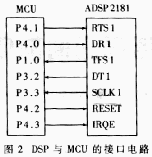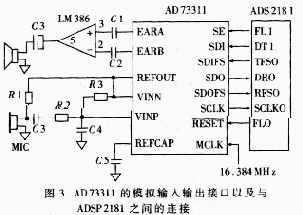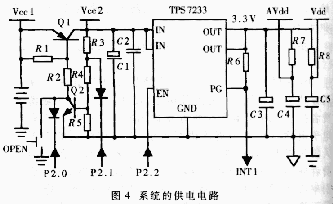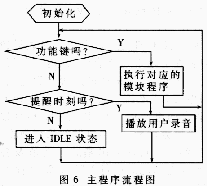The existing electronic telephone directory in the country uses the keyboard pinyin input method for inquiry, and has no dialing function, which is inconvenient to use and is not easily accepted by consumers. At the end of 1998, the voice electronic telephone directory that was just published in western developed countries was an English voice prompt. It was extremely inconvenient for Chinese people who use Chinese, and the function was single and expensive. It was not suitable for Chinese consumers. We have developed a Chinese multi-function voice electronic telephone directory suitable for China's national conditions with strong functions, excellent performance, low price and high recognition rate. It has a broad market prospect in China with hundreds of millions of consumers. The successful development of this product is for China. The research of speech recognition algorithms and the development of speech products are of special significance.
This article refers to the address: http://
The user only needs to speak the Chinese name or the unit name of the person being queried, and the voice electronic telephone directory can use the high-tech such as voice recognition and voice synthesis to play back and display the corresponding telephone number and automatically dial.
1 Voice electronic phone book function
· Voice phone book function
It can store 800 phone numbers with 200 names. There are 4 phone numbers with 32 digits under the word. It has the functions of searching, dialing, modifying, deleting, long-distance area code automatic filtering, voice prompt, voice playback, display, battery alarm, power automatic opening and closing.
· Voice Notepad function
It has two voice reminder timer reminders, which can automatically play a 1 minute user recording whenever the voice reminder timing reminder arrives to remind the user.
· Calendar / clock function
Can display year, month, day, hour, minute, second, week.
· Calculator function
2 voice electronic telephone directory system
The system consists of master and slave function modules. The main function modules include MCU, keyboard and LCD; the slave function modules include DSP, CODEC, ROM, FLASH and audio amplifier, as shown in Figure 1. The functions of each module of the system are as follows.

(1) The main function of the DSP is to receive the commands sent by the MCU, and complete the functions of voice training, voice recognition, voice synthesis, DTMF dialing, directory management, and notebook management according to the commands. Because AD's ADSP2181 has powerful digital signal processing capabilities and a variety of peripheral interfaces and high performance price ratio.
(2) CODEC is used to complete the D/A (analog voice signal into digital voice signal) and D/A (digital voice signal into analog voice signal). Because AD's AD73311 has many excellent performances, such as A/D with 16-bit signal-to-noise ratio of 75dB and D/A with 70dB signal-to-noise ratio, the sampling frequency and input/output gain can be programmed, with its own reference voltage and Low power consumption and serial input and output interfaces.
(3) ROM is the data needed to store DSP programs and voice prompts.
(4) FLASH is used to store 200 item data of the telephone directory and two pieces of 1-minute note recording data required by the notebook.
(5) The MCU in the single-chip system mainly accepts keyboard commands, sends control commands to the DSP, receives feedback information from the DSP, and displays some information on the LCD; it is also responsible for calendar/clock generation and calculator functions. SUMSUNG's KS57C2308 microcontroller has 40 I/O pins that can directly drive 16-bit 8-segment LCDs; 2 to 5.5V wide voltage; low power consumption and low price.
(6) The main function of the power module is to provide power to each function module in the system, through which the power of the slave function module can be turned on or off manually or automatically.
3 voice electronic telephone number thin interface circuit design
3. l Interface design between ADSP2181 and MCU
The ADSP2181 operates as a slave chip that receives and processes commands sent by the MCU at any time and returns status and data to the MCU. The interface between the ADSP2181 and the MCU can be divided into serial mode and parallel mode. However, since the hardware and software design of the serial interface mode is relatively simple, and the hardware resources of the DSP and the MCU are small, the serial interface mode is selected in the system, as shown in FIG. 2 .

Set SPOPT1 of ADSP2181 to serial port mode, connect to MCU through five wires, SCLK1 is serial clock output terminal; RFS1 and TFS1 are receive frame sync and send frame sync signal lines, respectively, which are used to indicate serial data words. The start of DR1 and DT1 are the receive and transmit signal lines of serial data, respectively, and the data bits are synchronized with the serial clock SCLK1. In addition, there are two control signal lines IRQE and /RESET. The MCU P4.3 is connected to the IRQE end of the ADSP2181. After receiving the interrupt signal, the ADSP2181 exits the IDLE state and starts receiving commands from the MCU. P4.2 is connected to the /RESET terminal of the ADSP2181 to control the reset of the DSP. After the DSP program is started, the related initialization work is performed first, and then the IDLE state is entered to wait for the interrupt signal of the MCU.
3.2 Interface between ADSP2181 and CODEC and analog input and output interface design of CODEC
The interface between ADSP2181 and CODEC and the analog input and output interface circuit of CODEC are shown in Figure 3.

The left side of the CODEC AD73311 is the analog input and output interface. The analog input interface uses a single-ended mode, and the analog output interface uses a differential double-ended output. R2(100)Ω and C4 (0.047μF form the anti-aliasing filter at the input. Due to oversampling, the single The RC filter of the pole is sufficient. The minimum load resistance at the output of the AD73311 is 150Ω. Since the 32Ω speaker is used, the LM386 is added as a power amplifier before the speaker. The right side of the AD73311 is the digital interface with the ADSP2181. , /RESET is the reset terminal, SCLK is the serial clock output terminal; SDO, SDOF are the serial data output terminal and the synchronous signal terminal; SDIF, SDI are the serial input synchronous signal terminal and the data terminal; SE is the serial port enable SDI, SDO and SCLK are respectively connected to DTO, DRO and SCLKO of ADSP2181 serial port 0; MCLK is the external main frequency clock input terminal, from the external crystal oscillator, its frequency is 16.384MHz, we use the oversampling method to extract and Filtering to obtain a higher signal-to-noise ratio, the sampling frequency of AD73311 is Fad=32kHz; we adopt the asynchronous method of transmitting and receiving frame synchronization signals, so that the TFSO of ADSP and the SDIF of AD73311 are respectively S, SDOFS is connected.
3.3 Voice Electronic Telephone Number System Power Supply Circuit Design
The power supply circuit of the system is shown in Figure 4.

Since the system is a consumer hand-held machine, the product is powered by three 7-cell batteries in terms of volume, weight, price, and the like. In order to extend the battery life, the power consumption of the system should be reduced. Therefore, the system uses low-power DSP and CODEC chips, and implements 3.3V power supply for them. This system uses TI's TPS7233 micropower low drop voltage regulator, /EN is the enabler of the regulator, the high level will turn off the regulator to enter the micro power sleep mode; PG is the work The normal state output, when its output voltage drops to 95% of its normal value, the output goes low, which can be used as a battery undervoltage indication. In order to make the audio amplifier in the AD73311 analog output channel get enough power and improve the anti-interference ability of the system, the power supply to the LM386 should be taken out from the front end Vcc2 of the TPS7233. In order to perform the calendar/clock display normally, the MCU power supply is directly taken out from the battery terminal Vcc1, in order to save power, the MCU
Usually works in the IDLE state. In order to effectively suppress noise, the CODEC analog power supply is taken from the AVdd terminal, and the DSP, FLASH, ROM, and CODEC digital power supplies are taken out from the Vdd terminal. When you need to enter the directory work and press the /OPEN button, the MCU's P2.2 output low enables the TPS7233, because the /OPEN button presses the low level to make Q1 saturated, and the P2.1 output is high. The level also ensures the saturation of Q2, which turns on the power from the function module and enters the working state of the directory. When it is necessary to turn off the power from the function module, the P2.1 output of the MCU is low, so that Q2 is turned off, and thus Q1 is also turned off and its power is turned off. When the timed voice reminder of the notebook arrives, the P2.2 and P2.0 of the MCU output a low level, and the P2.1 outputs a high level, which also turns on the power of the function module, thereby entering the working state of the notebook. In the working state of the notebook or the directory, if the battery is under voltage, the PG changes from high level to low level and a falling edge occurs. The MCU requests an interrupt, and the MCU turns off the function module in the interrupt 1 service program. The power supply, while the LCD shows the battery under voltage flag, reminds the user to replace the battery in time.
4 voice electronic telephone number thin software design
The software system includes two major modules: DSP software and MCU software. The software of DSP is mainly based on the digital signal processing technology of voice signal to complete the functions of speech recognition and speech synthesis. Due to limited space, it will not be introduced here. The MCU software adopts a structured programming method, and each module has certain independent functions, which facilitates the function expansion and maintenance of the system.
4.1 Basic Timer Interrupt Service Program Module
The flowchart is shown in Figure 5, and the service program is executed once every 7.82 ms. It completes the keyboard scan function. When the key of the same key value is detected for 20 consecutive times, the key value is placed in the keyboard buffer; it also completes the calendar/clock timing function, when the clock timer is detected twice in succession. When the interrupt flag bit IRQW is 1, the second of the clock is incremented by one. If the program when the interrupt occurs, it works in IDLF mode. At this time, the LCD should display the calendar/clock information, and the interrupt will return normally. If it works in the telephone directory or the notebook program, if there is no key press within 2 minutes, then Turn off the power from the function module and return to an initialization address by an abnormal interrupt. Otherwise, the power supply from the function module is turned off. If the normal interrupt returns to the original breakpoint address, it must crash.

4.2 main control module
The module is designed based on the system's operational flow, as shown in Figure 6. The program first determines whether there is a function key press. If no function key is pressed, and the voice timing reminder moment of the notebook has not arrived, the CPU clock is switched to the sub clock and the main clock is turned off, and the IDLE_FLAG is set to 1 and enters the IDLF state. . After the basic timer is interrupted, the main program will exit the IDLE state and repeat the above process without pressing the function key. If there is a function key pressed, clear IDLE_FLAG to 0 and execute the corresponding function module program.
In short, compared with the internationally leading similar products produced by Sensory, the voice electronic telephone directory we developed has the following advantages?
· The recognition rate is greater than 99%, which is increased by two percentage points;
· Added the functions of notebook, calculator, calendar/clock display, local long-distance area code filtering, etc.
· Both voice and key operation;
· Small size and light weight, the price is one-half.
24V Frequency Transformer,110V 60Hz To 220V 50Hz Transformer,Oil-Filled Electric Transformer, electronic oiled transformer
IHUA INDUSTRIES CO.,LTD. , https://www.ihua-magnetics.com